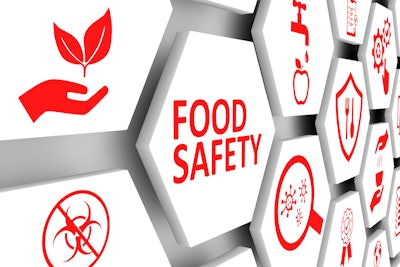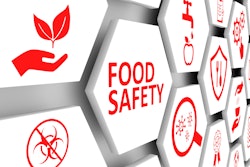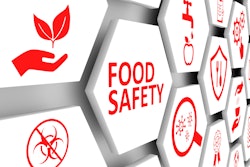
The number 7 is often associated with good luck. However, in the wrong hands, this number can quickly turn deadly for your facility if any or all of these seven sins are committed. Failed inspection scores. Wasted product. Costly downtime. These problems are common in food processing and distribution facilities, and are often caused by safety lapses. From lack of employee training to poor pest management , these lapses—or Seven Deadly Sins—aren’t unavoidable.
With an integrated, expert-led approach to food safety, you can root out the causes of negative outcomes while meeting regulatory pressures and market demand. Here are the sins to watch out for, and what you can do to absolve them.
1. Spillage and cross-contamination
Protein spills can cause cross-contamination, which leads to unplanned downtime, waste and potentially even a costly, reputation-damaging recall. Although there are countless ways for cross-contamination to occur, ranging from the process of unloading of raw materials to poor employee hygiene, spillage is often entirely preventable.
Effective prevention of cross-contamination is like a puzzle, where plant and equipment layout, production and warehousing procedures and employee training are all considered part of a holistic approach. Through well thought out facility and distribution design mapping, you may be able to prevent allergens from intersecting with non-allergens in your facility. In instances where you are unable to prevent those intersections from occurring, implement mitigating steps to stop cross-contamination from occurring such as sanitization or swapping out machine components.
2. Pests
Food processing facilities and warehouses are a treasure trove for pests, especially for species that have evolved to rely on human activities for sustenance. Like cross-contamination, prevention is essential. By cutting off pests' food sources—inside and outside—you can deter them from discovering your facility. Trash, mulch, excessive foliage and standing water outside of the facility attract pests. Uncleaned product spills, improperly stored materials and poor sealing inside the facility invite them in.
Prevention alone won’t completely eliminate the need for professional pest management, but it does allow you to focus treatment protocols on the most invasive species. Pheromones, growth regulators and baiting systems target many of the more common stubborn pests while also keeping food products safe.
3. Poor audit documentation
As regulatory pressures increase, the amount of data you manage keeps snowballing. Many food processors rely on technology to simplify documentation and avoid the additional scrutiny, fines and reputational damage caused by poor inspection preparation. But with so much more data to manage, simplicity can be elusive.
For example, the Food Safety Modernization Act (FSMA) requires that you maintain up to date employee training logs, including when trainings were conducted, who was in attendance, what topics were covered and have that documentation readily available to any auditor when asked. In addition, as an industry best practice you should also have a history of revisions made to your master sanitation schedule (MSS) and any standard operating procedures (SOPs) that your teams work with every day.
Although significant inroads are being made to capture key sanitation metrics in order to have a digital documentation trail for validation of activities. On its own, technology isn’t the only solution for meeting these requirements. You also need well-defined documentation procedures that outline how you will use technology, and who has access to and is responsible for the data, recordkeeping and reporting.
4. Air quality and temperature issues
Even though air quality and temperature play an important role in food safety, they’re often overlooked. Inadequate filtration can increase the number of particulates in the air, which can compromise food safety and increase the odds of workers getting sick or even cross-contamination incidents. High humidity levels in refrigerated environments can cause ice or water to form on surfaces, increasing the odds of accidents as well as product spoilage due to improper temperature controls and monitoring.
Maintaining safe temperatures and proper levels of air quality depends on having an HVAC system that is designed for your specific environment and is installed properly by a certified technician. Preventive maintenance (PM) practices for all operational assets also plays a critical role in maintaining air quality. It is imperative to ensure the systems are working effectively and efficiently through properly scheduled PMs that include regular filter and belt changes, checking for leaks, as well as overall motor integrity.
5. Poor environmental health and safety (EHS) management
Keeping employees and customers safe is always a top priority, but production pressures sometimes cause food processors and distributors to fall short in the delivery of EHS programs. Food processors and warehousing companies face unique challenges—from maintaining product freshness to meeting increasingly stringent regulations—that make EHS management more complex than other manufacturing and distribution environments.
To overcome these challenges, EHS programs need to be fully integrated into production workflows. Processes should be digitized wherever possible. By promoting a safety of culture, everyone working in the facility can do their part to prevent accidents and illnesses. By incorporating a meaningful moment of safety message into your organizations daily workflow and activities is a very simple way to ensure the core message of safety is always top of mind.
6. Misalignment of key stakeholders
Misalignment between the general/facility management team and the food safety and quality team can often be the underlying dynamic. While general/facility management teams are focused on maintaining production up time or product throughput metrics, they may be unaware of what is happening on the floor. Conversely, the food safety and quality team is focused on meeting day-to-day demands for cleanliness, safety and the absolute need to stay audit ready 24/7. And they’re focused on different aspects of operations. The facility team is measured on budget, while the food safety team is measured on inspection scores.
Both teams play an important role in meeting safety and quality standards, so they shouldn’t operate in silos. To establish a true, consistent quality culture, they should be aligned on common goals and shared metrics. Understanding what is important to each team or department is the mutual value dynamic most critical to mitigating these sins before they are committed. Opening the lines of communications between different stakeholders to discuss their mutual value drivers is still the most effective way for all parties to succeed.
7. Improper training
No matter how advanced your equipment or how meticulously planned your processes, they’re only as good as the people delivering them. When employees or contractors don’t receive comprehensive, regular training on chemical usage, clean-in-place systems, hazard analysis and critical control points (HACCP) principles, as well as company-specific rules and regulations, it will lead to a litany of issues. Untrained or improperly trained employees can commit these deadly sins unwittingly because they don’t know how to maintain proper documentation, complete a master sanitation schedule or follow sanitation-based SOPs, and are more likely to have an on-site recordable accident.
Outline mandatory training schedules and topics in advance so they can be integrated into your daily operations. Hold employees accountable for completing and putting lessons into practice by reminding them that following all policies and procedures for risk management and food safety is a shared responsibility. Incorporate refreshers and reinforcement training with awareness programs (such as posters or table tents) and daily or weekly lunch and learn training meetings.
Absolve yourself from food safety sins
Dealing with any one of these scenarios can be a nightmare for food processors and distributors, yet they’re all too common. The key is to view each issue in the broader context of your operational strategy, as opposed to separate activities. Work with in-house teams or an external food safety expert to develop an integrated approach to operating your facility, inclusive of considerations for cross-contamination, pests, mutual value alignment, air quality, safety, training and documentation.
That’s how you can continue to meet regulatory pressures and prevent the sins of food safety lapses in your facility.


















